Gochujang paste brings deep and savory flavors to this easy to make Korean BBQ Beef Jerky. A little spicy, salty and sweet, it is tender and flavorful with no added preservatives!
Beef Jerky is one of our favorite things to create, enjoy and share. It is so easy to make and there are so many flavor possibilities!
The flavor profile of Korean BBQ Beef Jerky is inspired by our new found love of Gochujang paste, a fermented condiment used in Korean cooking. This jerky is absolutely delicious with the perfect spicy savoriness!
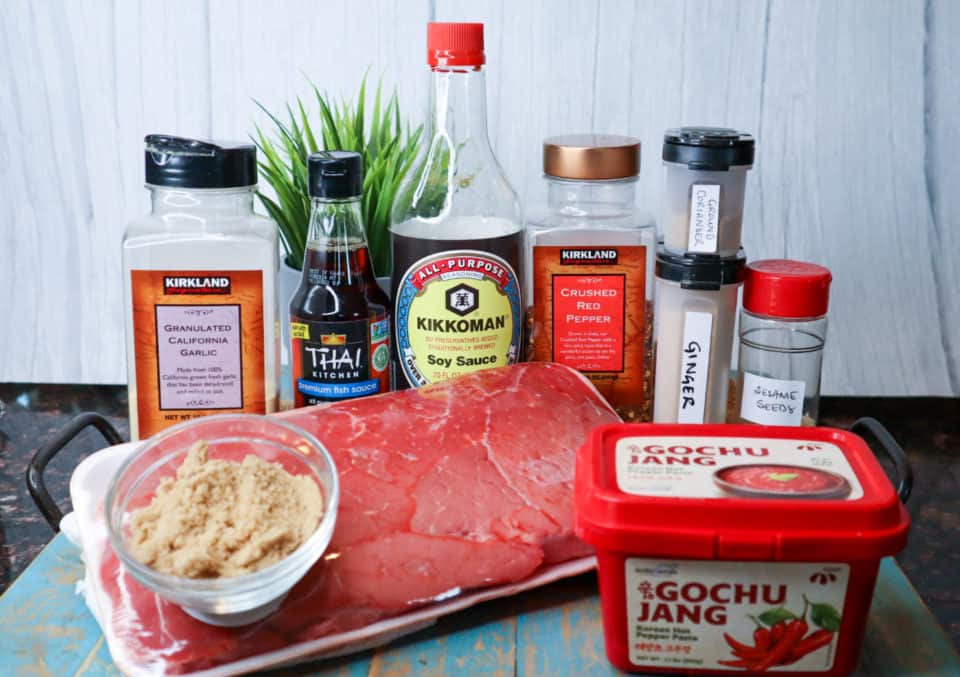
What you’ll need to make Korean BBQ Beef Jerky
- top round or London Broil
- Gochujang
- soy sauce
- brown sugar
- chili flakes
- fish sauce
- garlic powder
- ground ginger
- ground coriander
- sesame seeds
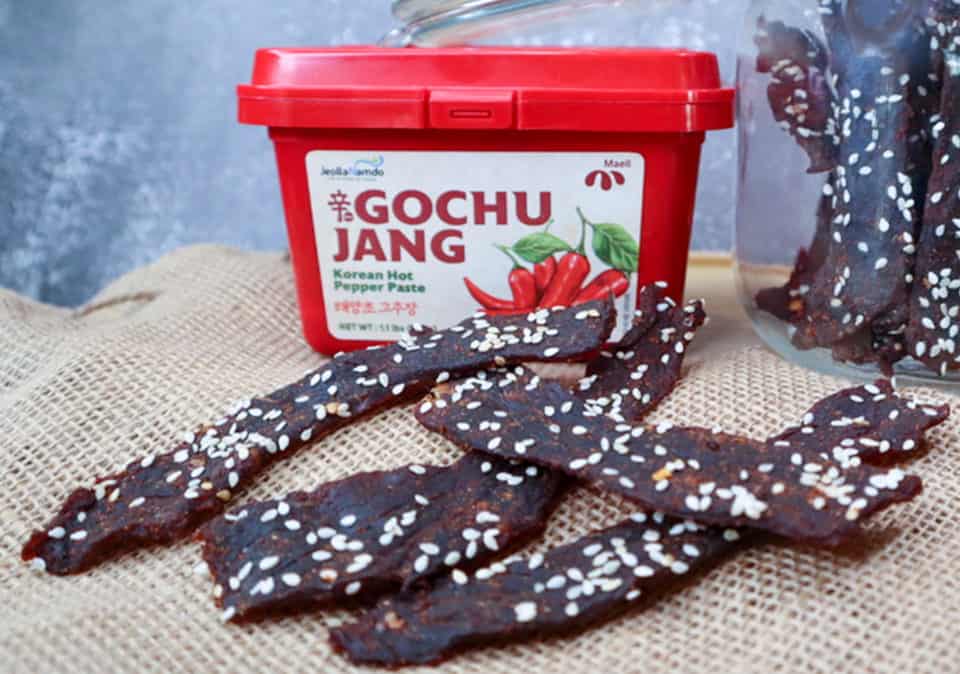
What is Gochujang?
Gochujang is a fermented red chili paste that is a fundamental ingredient in Korean cooking. It has actually been around for hundreds of years but has been steadily making its way into American dishes. It adds a deep savory, slightly sweet flavor and is a great addition to sauces and marinades!
What does Gochujang taste like?
Real Simple explains that Gochujang is like the love child of sriracha and miso—spicy like the former, pungent like the latter—with a hint of sweetness.
Where can you buy Gochujang?
Gochujang can be found in the Asian aisle of most larger grocery stores, at Asian markets and our favorite – on Amazon!
The Secret to Making Flavorful Beef Jerky
The thing with beef jerky is that it requires both a flavorful marinade and soak time. The meat needs to be in that marinade for long enough that it will soak in all of those flavors. Sometimes the flavors need some tweaking and refinement and a few retries before it is just right and I’m not going to lie – getting jerky just right is kind of an art.
The first time that I made jerky, I was so excited to make it that I only let it marinate about 12 hours. The result was that the jerky was fine but it wasn’t flavorful. Like not at all. It was just kind of… boring.
Now when I make jerky I put the meat into the marinade and put it into the refrigerator and leave it for an absolute minimum of 24 hours, sometimes up to a week! Typically, around the 72 hours I am super happy with the result.
You need to find what’s right for you but the longer in has time to take in the marinade, the deeper the flavors of the jerky! Don’t be afraid to experiment and find your happy place!
The UDSA has a great page with all sorts of facts about Beef Jerky here.
TEN TIPS FOR MAKING BEEF JERKY:
- London Broil (Top Round) makes a very tasty jerky. Strips need to be cut between 1/8 and 1/4 inch thick. NO THICKER THAN THAT.
- How you cut the meat determines the final result. Evenly, thinly, and against the grain are key.
- Marinate, marinate, marinate. What you put the meat in and how long you leave it there for really determine the final result. Marinating under 12 hours is not going to get you the taste you want. You have to let the meat take in the flavor. You can’t rush it. You have to pay attention. Move the meat around while marinating and turn the bag repeatedly while it marinates. A ziploc bag is a great thing for marinating as it is pliable and the meat can be moved around without opening the bag.
- Be careful with salt. Salt seems to be the first thing that gets soaked up into the meat. You can’t take it out once it’s in. Too salty = bad. Use garlic POWDER and onion POWDER, not the salt versions.
- Taste and smell your marinade. If it is tasty before adding the meat, the jerky will turn out great.
- Marinate in the refrigerator. No one wants food poisoning.
- A food dehydrator is a good investment. The oven can be used but it is harder to get a great end product and it takes longer.
- When a recipe says it’ll take 5 hours, start checking it at an hour and a half. Timing depends on temperature, thickness and moisture, not what a cookbook says.
- Don’t be afraid to move the meat and the trays around. Also, don’t be afraid to remove the thinner pieces that are done before the thicker ones. No one is perfect when cutting meat into strips. Check often!
- And finally, don’t ever put meat in the dehydrator and go to bed, thinking it will be done in the morning. If you do this, you will get over dried jerky that will most likely be inedible. After all that marinating time, it is really sad to have to throw it out!
What if I don’t have a Dehydrator?
I get asked a lot if you can make jerky in an oven. Of course you can! You would prepare and marinate the meat exactly as above but instead of putting it onto dehydrator trays, preheat the oven to the lowest temperature it will preheat to. Usually this is 170 – 175 degrees F. Position the racks to the upper-middle position.
Line two large baking sheets with foil and then place a wire cooling rack onto each. This allows the meat to have some air flow. Lay the marinated beef strips out onto the wire racks and bake until it is dryer and considerably less spongy than it was going in.
Much like a dehydrator, it is important to pay attention to the meat by moving the jerky around and rotating the trays. Feeling the jerky with your fingers is the best gauge of done-ness. Cooking times vary upon the thickness of the meat and this process can take anywhere from 2-5 hours. Enjoy!
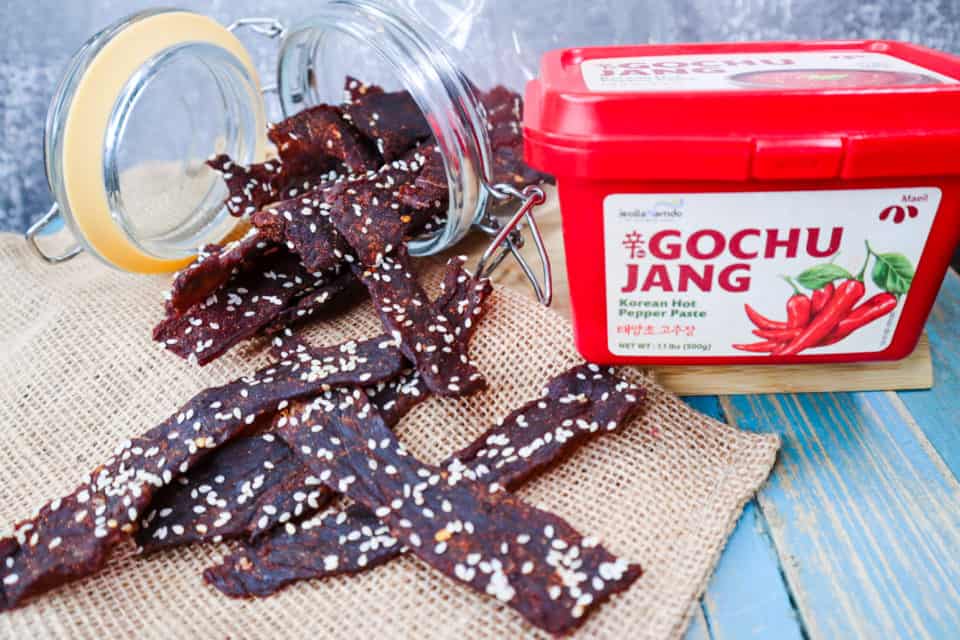
How to Make Korean BBQ Beef Jerky
The flavor profile of Korean BBQ Beef Jerky is inspired by Gochujang paste, a fermented condiment used in Korean cooking. This jerky is absolutely delicious with the perfect spicy savoriness!
Beef Jerky is simple to make. It can be made in the oven, but we prefer to use an electric food dehydrator.
Guidelines for using an oven are included below, just in case you don’t have a dehydrator and want to give this recipe a try.
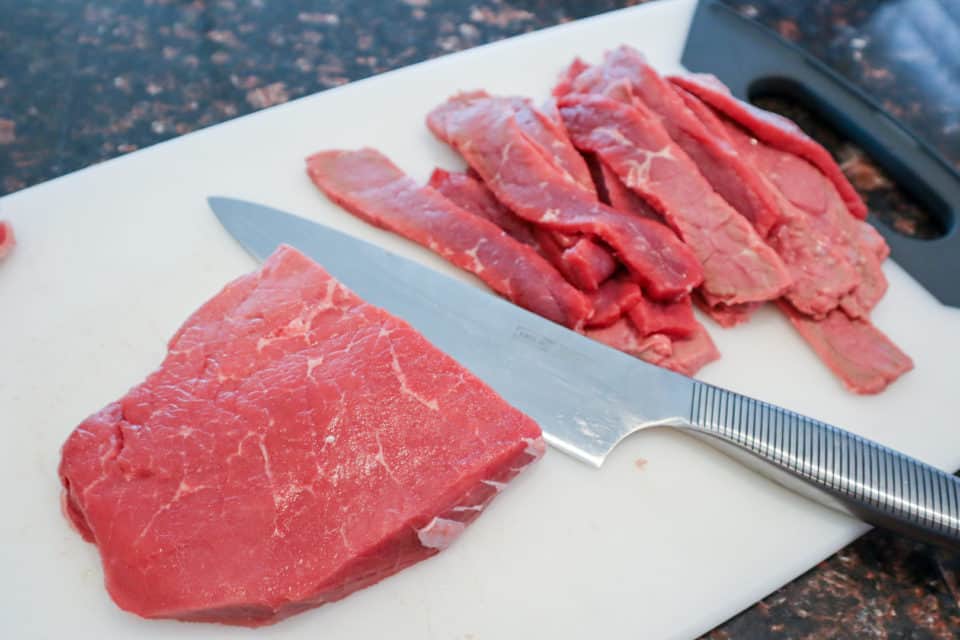
Slice top round into jerky strips against the grain, removing any large fat or connective tissue.
Place the jerky strips into a large zip top bag and set aside.

Cutting the Beef into Jerky Strips
– Cut the beef when partially frozen.
– Cut against the grain.
– Strips cut between 1/8 and 1/4 inch thick.

In a small bowl, mix together gochujang, soy sauce, brown sugar, chili flakes, fish sauce, garlic powder, ginger and coriander.
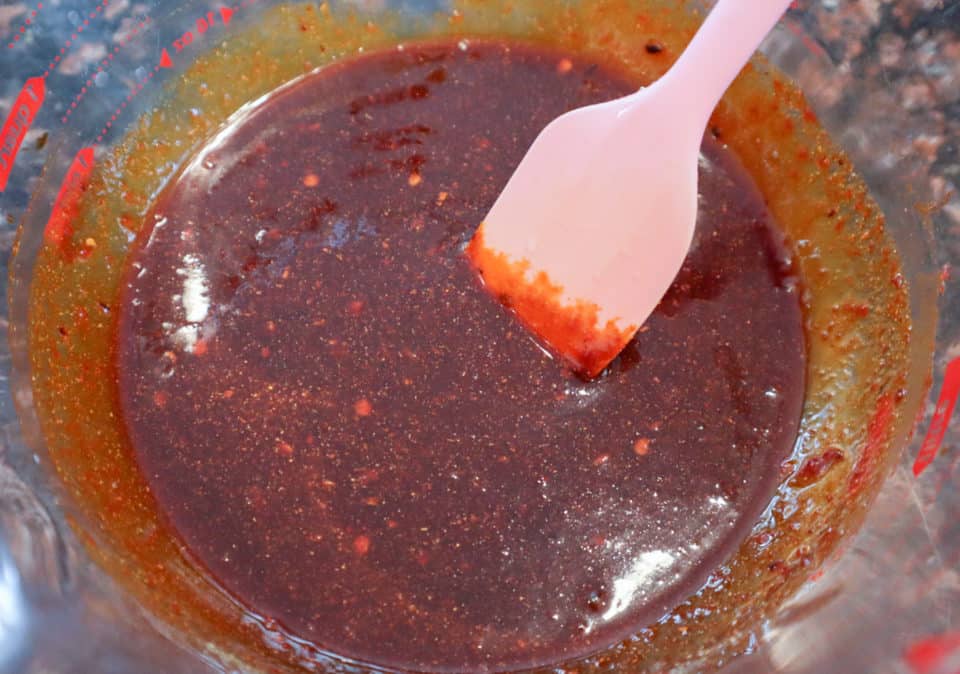
Stir until well combined and smooth.
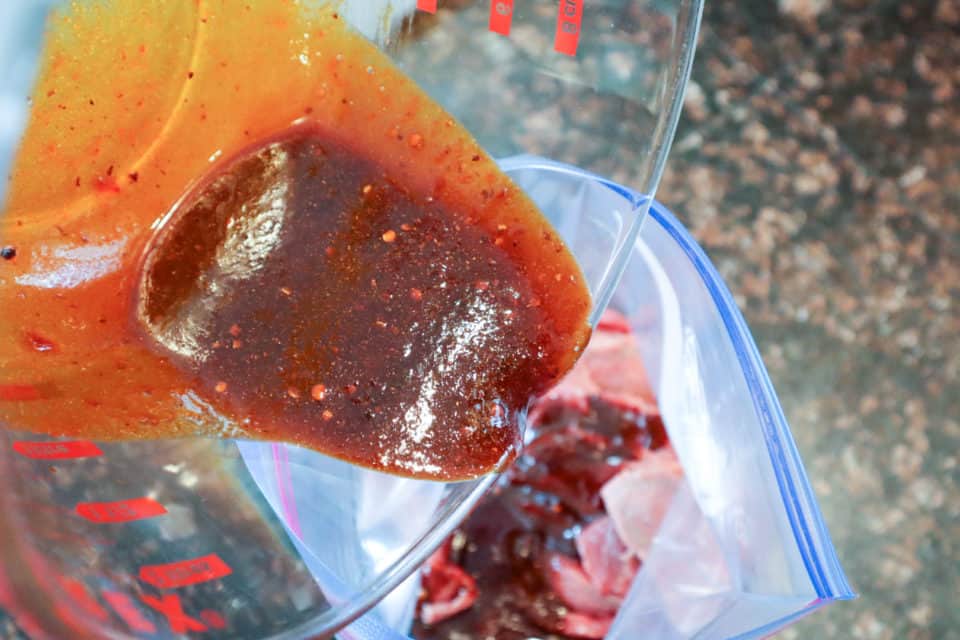
Pour the marinade over the jerky strips.
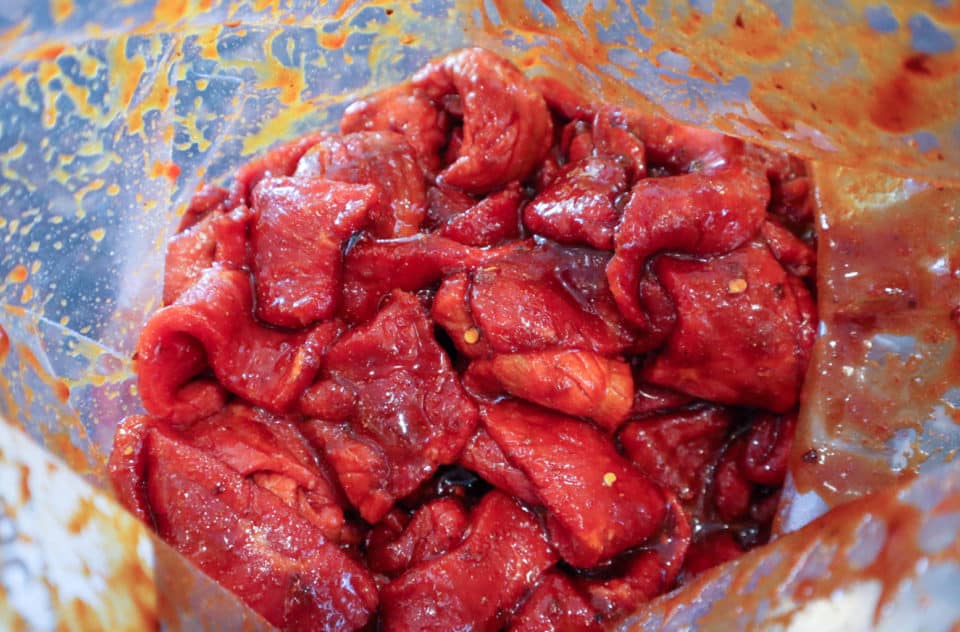
Remove the air from the bag and seal. Squeeze the bag to distribute the marinade, making sure the meat is coated evenly.

Refrigerate for 24 – 72 hours, up to a week, turning bag occasionally.
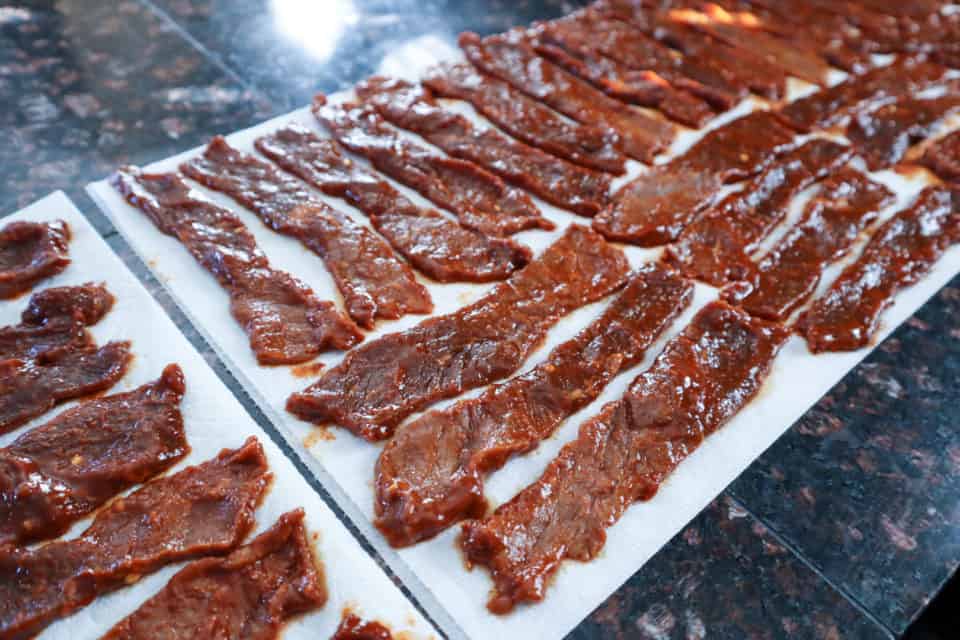
Lay the jerky strips out on paper towels to remove excess moisture.

Blot tops of strips with paper towels, removing as much as possible.

Sprinkle the jerky strips with sesame seeds.
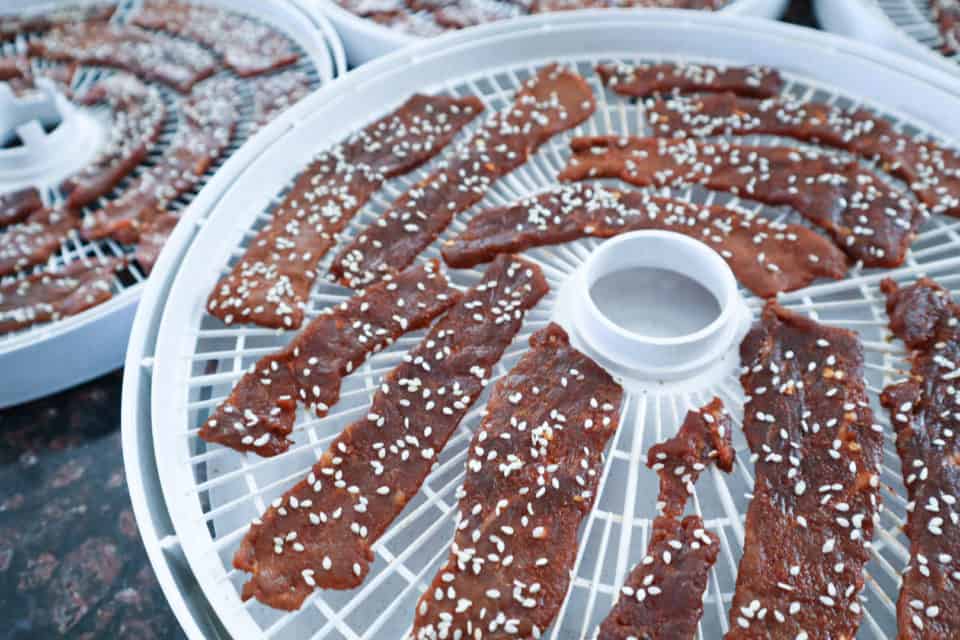
Lay jerky strips on dehydrator trays leaving room between for air flow.

Use as many trays as necessary.
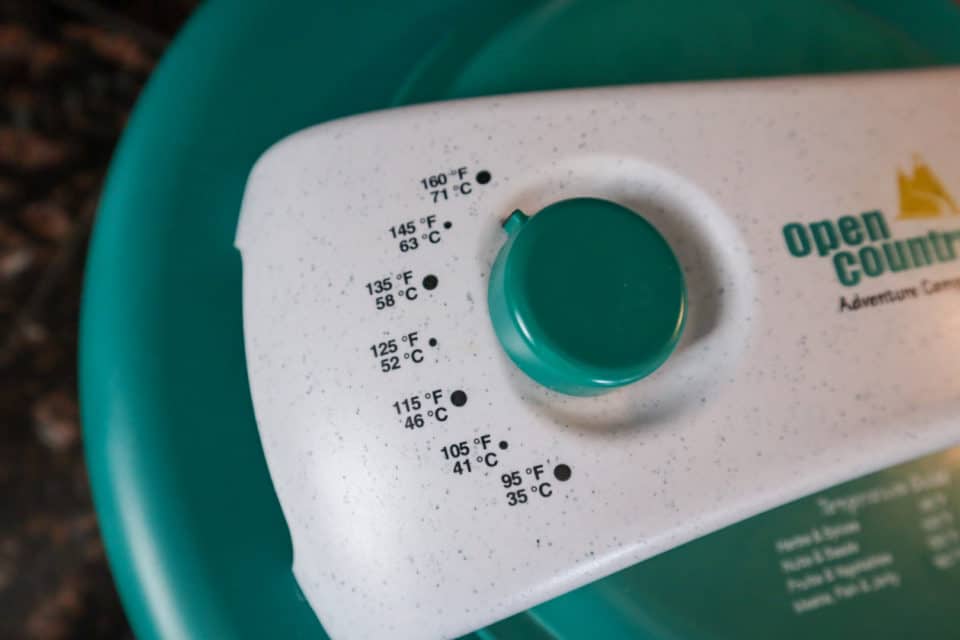
Turn the dehydrator on to highest setting and allow to dehydrate according to manufacturers directions, rotating trays periodically and checking the jerky every so often.
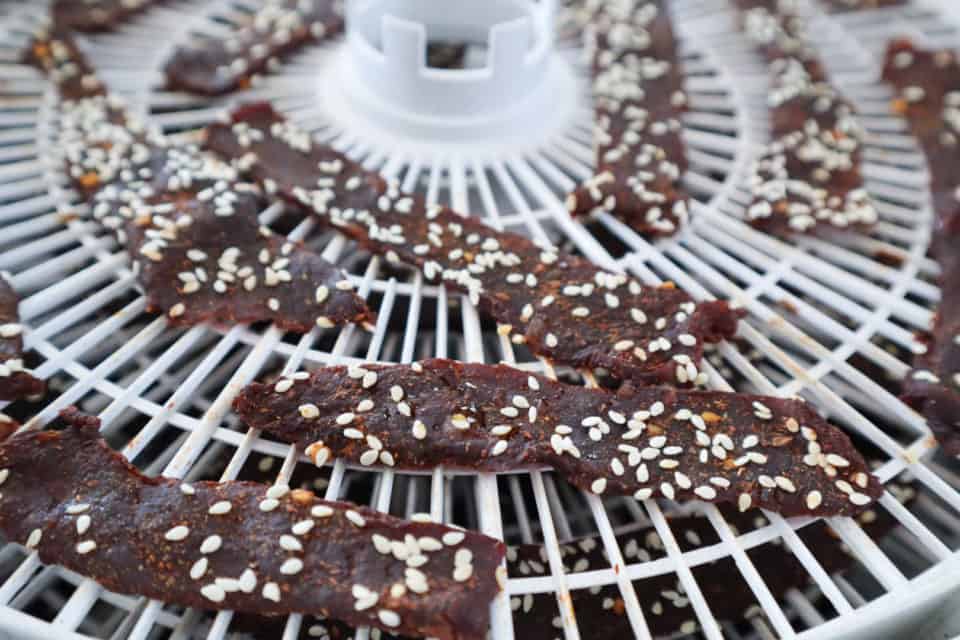
Once the jerky has been dehydrated sufficiently, remove from trays and allow to cool.
Store at room temperature in a zip top bag. Enjoy!
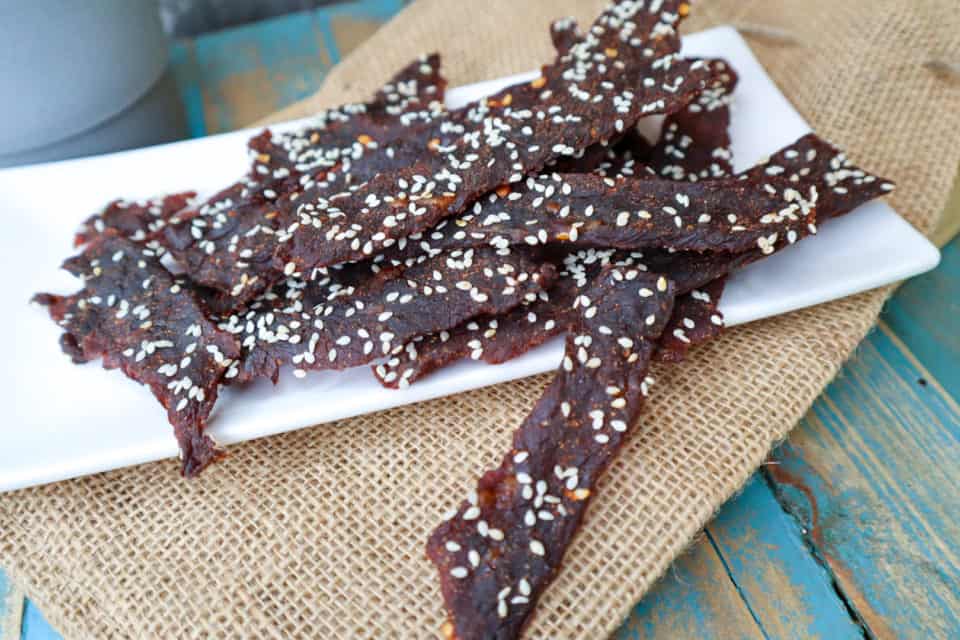
Other Favorite Easy Jerky Recipes
Black Pepper Beef Jerky – Bold black pepper bite – zesty and flavorful!
Worcestershire Beef Jerky – Our most requested jerky recipe with a a bold flavor that is undeniably good!
Spicy Dr. Pepper Beef Jerky – Sweet and tender with a low, subtle heat and a bold beefy flavor.
Teriyaki Sweet Hot Beef Jerky – Jerky with a sweet Teriyaki flavor and just the right amount of heat.
Sweet & Spicy Beef Jerky – Deliciously balanced between sweet & Spicy!

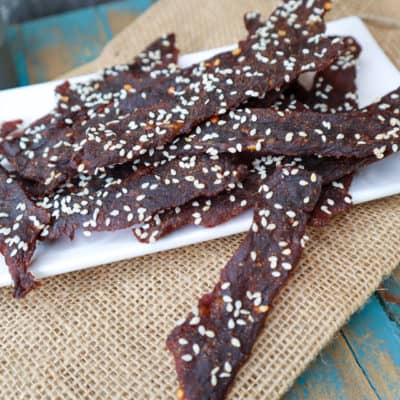
Korean BBQ Beef Jerky
Ingredients
- 1 pound top round or London Broil
- 1/4 cup gochujang
- 1/4 cup soy sauce
- 3 tbsp brown sugar
- 1 tsp chili flakes
- 1 tsp fish sauce
- 1 tsp garlic powder
- 1 tsp ground ginger
- 1/2 tsp ground coriander
- 1/2 tbsp sesame seeds
Instructions
- Slice top round into jerky strips against the grain, removing any large fat or connective tissue. Place the jerky strips into a large zip top bag and set aside.
- In a small bowl, mix together gochujang, soy sauce, brown sugar, chili flakes, fish sauce, garlic powder, ginger and coriander. Stir until smooth.
- Pour the marinade over the jerky strips, remove the air from the bag and seal.
- Squeeze the bag to distribute the marinade, making sure the meat is coated evenly.
- Refrigerate for 24 – 72 hours, up to a week, turning bag occasionally.
- Lay the jerky strips out on paper towels to remove excess moisture. Blot tops of strips with paper towels, removing as much as possible.
- Sprinkle with the sesame seeds and then lay jerky strips on dehydrator trays leaving room between for air flow. Use as many trays as necessary.
- Turn the dehydrator on to highest setting and allow to dehydrate according to manufacturers directions, rotating trays periodically and checking the jerky every so often.
- Once the jerky has been dehydrated sufficiently, remove from trays and allow to cool.
- Store at room temperature in a zip top bag. Enjoy!
Notes
Nutrition *
* The information shown is an estimate provided by an online nutrition calculator.



Leave a Reply